Your plants may be taking longer to grow due to inadequate sunlight, insufficient water, or poor soil quality. Evaluate these factors to promote healthy plant growth.
Plants may be taking longer to grow for a variety of reasons, and understanding these factors can help you address and resolve the issue. Factors such as inadequate sunlight exposure, improper watering, or poor soil quality can significantly impact plant growth and development.
By identifying and addressing these issues, you can create an environment that promotes healthy and robust plant growth. We will delve into the common reasons why plants may take longer to grow and provide practical tips to help you overcome these challenges in your garden or indoor space. Let’s explore the potential factors affecting your plant’s growth and how to address them effectively.

Credit: www.reddit.com
Factors Affecting Plant Growth
Light
Light is crucial for plant growth as it fuels the process of photosynthesis.
Temperature
Temperature plays a significant role in determining how well plants grow.
Water
Water is essential for plants to carry out various physiological functions.
Nutrients
Nutrients such as nitrogen, phosphorus, and potassium are vital for plant growth.
Soil Quality
Soil quality influences the availability of nutrients and water to plants.
Environmental Conditions
When it comes to the growth of your plants, the environmental conditions play a crucial role. Understanding how seasonal changes, location, and climate impact plant growth can help you optimize your gardening efforts.
Seasonal Changes
Seasonal changes greatly influence the growth rate of plants. During the warmer months, most plants experience rapid growth due to increased sunlight and warmth. Conversely, in the colder months, the growth rate tends to slow down. Understanding the impact of seasonal changes can help you adjust your planting and nurturing practices according to the specific needs of your plants.
Location
The location of your plants plays a significant role in their growth rate. Different areas of your garden may receive varying levels of sunlight, affecting plant growth. Additionally, shaded areas may cause slower growth compared to areas receiving ample sunlight. Ensuring that plants are positioned in optimal locations based on their sunlight requirements is crucial for consistent growth.
Climate
The climate in which your plants are situated also has a substantial impact on their growth. Some plants thrive in humid conditions, while others require drier environments. Understanding the specific climate preferences of your plants and adjusting your gardening practices to accommodate these preferences can result in healthier and faster growth.
Plant Species Variations
Plant species variations play a significant role in the time it takes for plants to grow. Each plant species has its own unique life cycle, genetic makeup, and specific needs that influence the rate of growth. Understanding these variations can help gardeners and plant enthusiasts cultivate their greenery more effectively.
Life Cycle
The life cycle of a plant refers to the stages from seed germination to maturity. Some plants have short life cycles, such as annuals, which complete their life cycle within one growing season. On the other hand, perennials have longer life cycles and may take several years to reach maturity.
Genetic Makeup
Genetic makeup determines a plant’s growth rate and potential size. Different plants inherit traits from their parent plants, influencing their growth and development. Some plants have genetic predispositions to grow faster or slower than others, affecting their overall growth timeline.
Specific Needs
Specific needs encompass factors such as sunlight, water, soil, and nutrients that are essential for optimal growth. Different plant species have varying requirements for these elements, which can impact the time it takes for them to grow. Understanding and fulfilling a plant’s specific needs are crucial for supporting its growth and development.

Credit: cannabis.net
Pest And Disease Infestation
Pest and Disease Infestation: One of the key reasons your plants might be taking longer to grow could be due to pest and disease infestation.
Identifying Pests And Diseases
Pests: Look for signs of pests such as holes in leaves or visible insects on plants.
Diseases: Check for wilting, yellowing, or spots on foliage which may indicate disease.
Prevention And Treatment
- Preventive Measures: Regularly inspect plants, maintain good hygiene, and avoid over-watering.
- Natural Remedies: Use neem oil or garlic spray to deter pests, and prune infected parts promptly.
- Chemical Treatments: Consider using pesticides or fungicides as a last resort under severe infestations.
Cultural Practices And Maintenance
Cultural practices and maintenance play a crucial role in the growth and development of plants. By understanding and implementing proper techniques, you can ensure healthy and thriving plants in your garden. Below, we will explore four key cultural practices that can significantly influence plant growth: pruning, weeding, fertilizing, and mulching.
Pruning
Pruning involves selectively removing specific parts of a plant, such as branches or stems. This practice helps promote optimal growth by eliminating dead or diseased parts, improving air circulation, and shaping the plant for aesthetics. Pruning also stimulates new growth and directs the plant’s energy towards productive areas.
Weeding
Weeds compete with plants for essential resources like sunlight, water, and nutrients. Therefore, regular weeding is essential to prevent these unwanted intruders from suffocating your plants. By eliminating weeds, you allow your plants to receive maximum nutritional benefits and ensure optimal growth.
Fertilizing
Fertilizing provides plants with the necessary nutrients they need to thrive. While soil naturally contains essential nutrients, it may not always be enough for optimal growth. Fertilizers rich in nitrogen, phosphorus, and potassium help supplement these nutrients and promote healthy plant development. It’s important to follow manufacturer instructions for the correct amount and application of fertilizers to prevent over-fertilization, which can harm the plants.
Mulching
Mulching involves adding a layer of organic or inorganic materials around your plants. This protective layer offers various benefits, including conserving soil moisture, inhibiting weed growth, and regulating soil temperature. Additionally, mulching prevents the soil from eroding and adds aesthetic appeal to your garden. Organic materials such as compost or bark chips are excellent choices, as they break down over time and enrich the soil with nutrients.
By implementing these cultural practices and maintenance techniques – pruning, weeding, fertilizing, and mulching – you’ll create an optimal environment for your plants to flourish. With careful attention to these essential tasks, you’ll be rewarded with healthy, vibrant, and flourishing plants in your garden.

Credit: humboldtssecretsupplies.com
Frequently Asked Questions Of Why Are My Plants Taking So Long To Grow?
How Do You Fix Slow Growing Plants?
To fix slow growing plants, ensure they have proper sunlight, moisture, and nutrients. Check for any diseases or pests and treat them promptly. Prune and trim regularly to stimulate growth. Repot if necessary and consider using fertilizers to boost plant health.
How Can I Make My Plants Grow Faster?
To make your plants grow faster, provide adequate sunlight, water regularly, use nutrient-rich soil, fertilize as needed, and ensure proper drainage.
What Causes Plants To Grow Slow?
Plants grow slowly due to factors like insufficient sunlight, poor soil quality, and over or under-watering. Additionally, inadequate nutrients, extreme temperatures, and overcrowding can also hamper their growth. Proper care, such as providing the right conditions and nutrition, can help accelerate their growth.
What Causes Stunted Growth In Plants?
Stunted plant growth can stem from various factors like inadequate sunlight, poor soil quality, drought, or overwatering. Nutrient deficiencies and pest infestations can also hinder growth. Regular monitoring and addressing these issues can help promote healthier plant development.
Conclusion
After understanding the factors hindering your plants’ growth, addressing them with suitable remedies will yield better results. Nutrition, sunlight, water, and patience are key elements in nurturing healthy plants. By being attentive to your plants’ needs, you can create an optimal environment for them to thrive.
Happy gardening!
